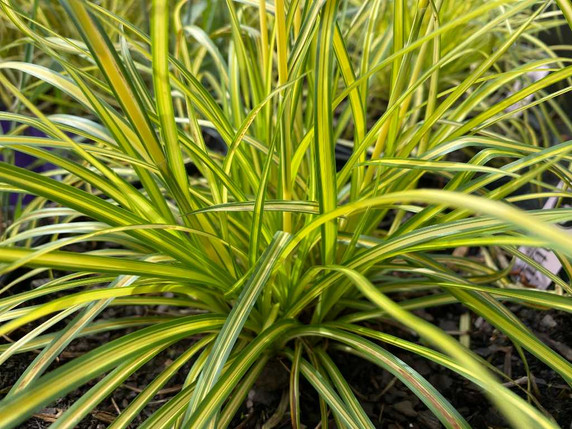Scirpus pendulus 'Stars and Stripes' - RUFOUS BULRUSH 'STARS AND SRIPES'
Cultivar of native grass-looking perennial, relative to sedges (Carex).
3/8" wide and 1' long leaves with bright yellow centers with some streaking, both gold and green, within the strong green edges.
Loves moisture, but will grow well in average soil with average moisture.
Blooming Time: July
Size: 18-24" tall x 24+" wide
USDA Zones: 4 - 8
Culture: full sun, half shade, average soils with some organic matter, loamy soils, organic rich soil, clayish. Average (medium) moisture, to moist or wet. Adaptable.
Moisture Needs: average (medium) to wet and waterlogged
Origin: Introduced by Brent Horvath - Intrinsic Perennial Gardens, Hebron, IL in 2024. The species of Rufous Bulrush is native to most of the states (except some central-western ones). Grows in swamps, moist fields, bottomlands, along rivers, moist prairies.
Deer/Rabbit Resistant: not known
Attracts Butterflies or Pollinators: no / yes (mostly moths, butterflies)
Attracts Hummingbirds: no
Pot Size: square 3.5" x 4" deep perennial pot
Pictures copyright: Intrinsic Perennial Gardens / Intrinsic Introductions
Plant combinations: For flower beds, areas around harden ponds water features, moist half shade beds, rain gardens, storm water areas, swales, water banks.
Can be combined with many perennials that do well in average moisture or in moist soil - Alchemilla, Amsonia, Asclepias incarnata, Baptisia, Chelone, Helianthus angustifolius and hybrids, Hemerocallis, Hibiscus, Iris (I. sibirica, I. x lousiana, I. versicolor, I. ensata, I. pseudata, I. virginica), Lobelia, Lysimachia, Mimulus, Persicaria amplexicaulis, Phlox paniculata (with smaller flowers), Phlox maculata, Physostegia, Sanquisorba, Thalictrum, Verbena bonariensis, Veronicastrum and grasses and sedges - Carex, Andropogon gerardii and cultivars, Calamagrostis, Chasmantium, Deschmapsia, Panicum, Pennisetum and Miscanthus (where these two are not invasive).

Scirpus pendulus 'Stars and Stripes' - RUFOUS BULRUSH 'STARS AND SRIPES'
Cultivar of native grass-looking perennial, relative to sedges (Carex).
3/8" wide and 1' long leaves with bright yellow centers with some streaking, both gold and green, within the strong green edges.
Loves moisture, but will grow well in average soil with average moisture.
Blooming Time: July
Size: 18-24" tall x 24+" wide
USDA Zones: 4 - 8
Culture: full sun, half shade, average soils with some organic matter, loamy soils, organic rich soil, clayish. Average (medium) moisture, to moist or wet. Adaptable.
Moisture Needs: average (medium) to wet and waterlogged
Origin: Introduced by Brent Horvath - Intrinsic Perennial Gardens, Hebron, IL in 2024. The species of Rufous Bulrush is native to most of the states (except some central-western ones). Grows in swamps, moist fields, bottomlands, along rivers, moist prairies.
Deer/Rabbit Resistant: not known
Attracts Butterflies or Pollinators: no / yes (mostly moths, butterflies)
Attracts Hummingbirds: no
Pot Size: square 3.5" x 4" deep perennial pot
Pictures copyright: Intrinsic Perennial Gardens / Intrinsic Introductions
Plant combinations: For flower beds, areas around harden ponds water features, moist half shade beds, rain gardens, storm water areas, swales, water banks.
Can be combined with many perennials that do well in average moisture or in moist soil - Alchemilla, Amsonia, Asclepias incarnata, Baptisia, Chelone, Helianthus angustifolius and hybrids, Hemerocallis, Hibiscus, Iris (I. sibirica, I. x lousiana, I. versicolor, I. ensata, I. pseudata, I. virginica), Lobelia, Lysimachia, Mimulus, Persicaria amplexicaulis, Phlox paniculata (with smaller flowers), Phlox maculata, Physostegia, Sanquisorba, Thalictrum, Verbena bonariensis, Veronicastrum and grasses and sedges - Carex, Andropogon gerardii and cultivars, Calamagrostis, Chasmantium, Deschmapsia, Panicum, Pennisetum and Miscanthus (where these two are not invasive).





